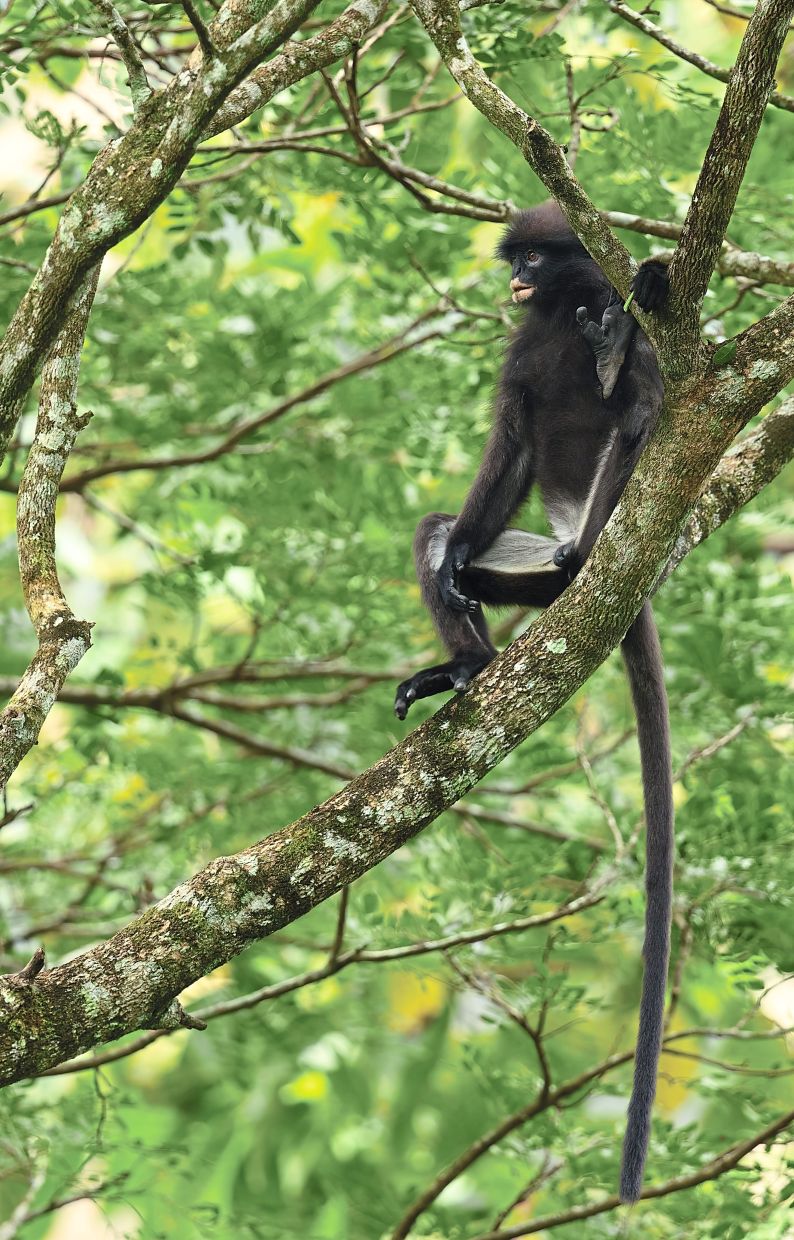A southern pig-tailed macaque and its baby. This species, also known as beruk among the locals, share over 93% of genome homology with humans. They are the preferred animal models or the study of human diseases.
A question. That’s all it takes to give purpose to your travel. Then it no longer becomes a meander or a wander.
Instead, it fills you with purpose and transforms your trip into a journey filled with discovery and wonder.
Mine started in 2017 when Dr Jane Goodall, the world-renowned naturalist and conservationist, asked me a simple question: How are the primates of Malaysia doing?
She was renowned for her ground- breaking research on chimpanzees back in the 1960s, which changed the definition of what it meant to be human.
Of course, I had no clue, like most Malaysians and the rest of the world.
It was a question mark. But I assured her this was quickly rectified as Malaysia remains one of the most technologically advanced nations.
Back then, we were even dreaming of a flying vehicle by 2020 (well, that’s another story for another day).
So I typed the question into the Google search bar, assured that an answer would appear in nanoseconds.
Nothing came up. Not even a comprehensive species list. I was quite appalled and ashamed.
For all the advancements and the race towards “first-world” status amidst the plethora of engineering feats that give our skyline some of the tallest buildings in the world, there were no answers on what was in our own backyard.
So after much research, contacting academics, Orang Asli, local village communities and relevant NGOs, I learnt that Malaysia had 25 species of primates (now officially 26 after a recent discovery), the second highest count in Asia after Indonesia, a country with a far greater land mass than ours. I thought that was incredible.
And yet, we know so little about our cousins that share our home with us.
Apart from the orangutan and the ubiquitous long-tailed macaque, most Malaysians would struggle to name the other unique primates that we have – not to mention all the other incredible wildlife found in our backyard that makes us one out of only 17 nations on the entire planet that can be declared as mega-biodiverse.
And so my journey began – to delve into the deep jungles and to reach for the high peaks – to search out Malaysia’s 26 primate species.
Project Monyet was birthed, and my journey continues to this day to learn more about our fantastic primate cousins and the different parts of Malaysia they call home.
Whether it is the mountainous forests, the mangrove swamps or even the semi-deciduous limestone hills, this question has allowed me to see Malaysia in a completely different light.
I could now see more than just the resorts, malls and towers. More than just the beaches and the swimming pools. More than just the buildings and highways.
I could finally see what made this land so rich and spectacular. I learned to see its tremendous biodiversity.
These journeys have brought me to all corners of the country. One of them involved an eight-hour car ride in Sabah – four hours from Kota Kinabalu to Sipitang followed by another four-hour ride off-road deep in the Bornean highland jungles to emerge at the tiny and remote village of Long Pasia in search of the mysterious Hose’s Langur of which not many photos or information exist.
And though I did not manage to see it despite trekking for a few days in the virgin primary rainforest, I got to experience the amazing hospitality of the Lundayo people and the beauty of the terrain.
We camped in the cool forest to be greeted by singing gibbons swinging above our hammocks in the early mornings, and the loud swooshes of the Rhinoceros Hornbill wings overhead would accompany our teatime snacks.
At night, fireflies danced among the trees, accompanied by the music of cicadas. It was the stuff of dreams indeed.
Not all the journeys need to be hiked. For example, one relatively easy primate to observe in the wild is the giant siamang, which can sometimes be found on the roads up to Genting Highlands, Bukit Tinggi or Fraser’s Hill.
Their loud cries in the mornings will usually indicate where to look. And, of course, you can also engage local guides to bring you along to see these magnificent apes located just an hour out of crowded urban Kuala Lumpur.
Another remarkable discovery is that rarely-sighted primates like the white-thighed surili can be discovered in the urban jungles of Kuala Lumpur.
On the green island of Bukit Kiara, an isolated population still thrives amidst the walkers, hikers, joggers and cyclists.
If you are on that hill, slow down and look above ever so often, and you might get to glimpse these unique primates in the trees above.
There are also huge eagles soaring above and colourful barbets flitting around. All you need to do is raise your eye level, slow down and see what is around you.
The moment will come when the greenery around you ceases to be just a bunch of trees and eventually, you will begin to notice the myriad of life forms around you – marvellous, curious, shy life forms, all of whom share this land with us.
Man’s greatest invention and folly is the concept of “property”. We deceive ourselves into thinking that our concept of ownership – the “right” and ability to enforce the exclusion of others – is a universal concept and prerogative.But nature knows no such concept. All she recognises is co-existence and balance. Literally, the laws of nature.
In that spirit, I encourage you to go on a journey. One that will allow you to meet some of our closest living relatives on the planet who share our DNA and our home.













